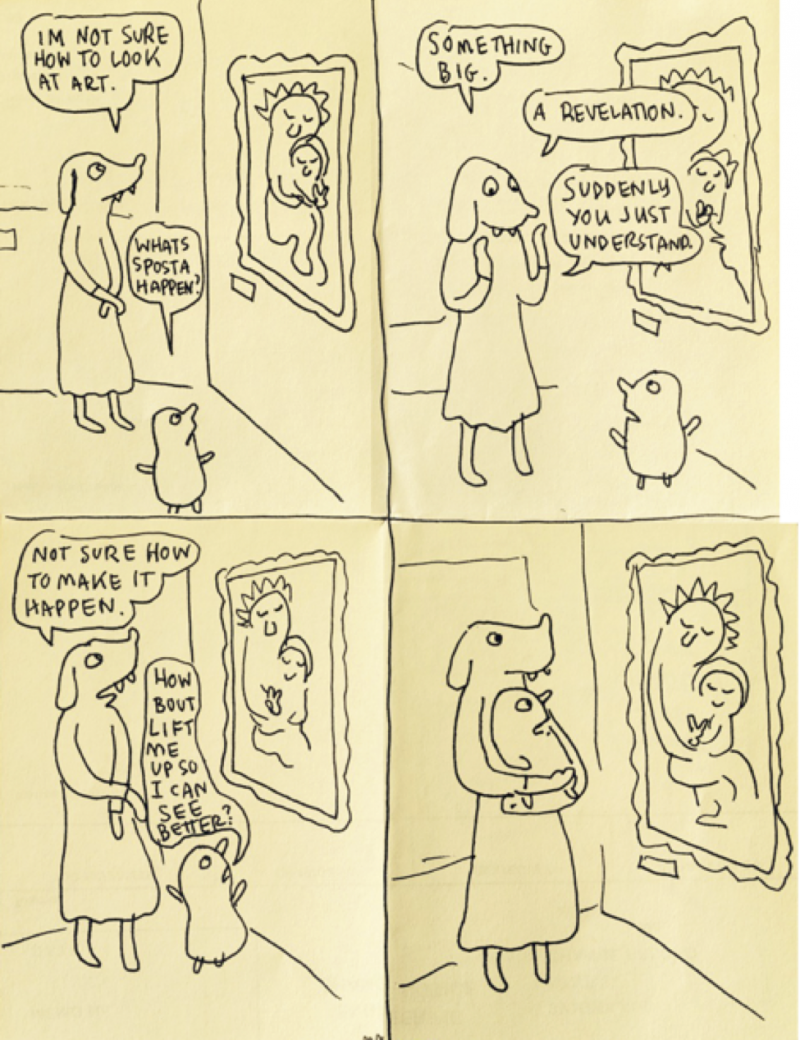
@luh_fondue asks
What do critics base their opinions on as it’s pretty much impossible for humans to be objective and not products of their time, experiences which inform their ‘taste’?
Your question answers itself, essentially. Art critics cannot be objective because after all – they’re human. I think the desire to assume an art critic has an objective opinion is based mostly in the art market and art history – which I think are one in the same, but that’s a whole other article.
Good and bad criticism
Collectors – essentially wealthy people with little interest in art – want to make a sound investment. A positive review can be very profitable for an artist (and art gallery). Andy Warhol said it best, “Don’t pay attention to what they write about you. Just measure it in inches.” It begs the question – would we even know who Jackson Pollock is without Clement Greenberg? Probably not. The majority of the viewing public – the other 99% of us – who aren’t buying the art, still want an informed opinion – or do we? Yeah. Do we need to read art criticism to look at art? No, you don’t, but for the majority of us art lovers reading art criticism goes hand in hand with viewing a work of art. For me, reading art criticism is a matter of taste in itself – there’s more bad art criticism than there is bad art. (note art critic shade) And now allow me to go on and get all subjective about art criticism…
Holland Cotter, Edith Newhall and Brian Doitcour
I recommend tuning into an old (2012) podcast/episode of Bad at Sports with New York Times Art Critic Holland Cotter. The critic gives a fantastic insight into the process of art criticism discussing their early childhood love of Asian Art that later propels their career in writing about art, particularly Asian and African Art. Most art critics tend to lean towards their personal taste. Edith Newhall, art critic for Philadelphia Inquirer, has a background in painting – which means they’re most likely going to be into reviewing your artwork if it’s painting. Of course Newhall reviews all kinds of art, but you can tell they enjoy writing more so about painting – and I enjoy reading it.
Brian Droitcour, who writes for Art in America, is an art critic I tend to stay tuned to when they’re writing about Internet Art. They are critical about the experience of viewing Internet Art in an art movement that can be so easily contrived – it’s their honest experience that keeps me reading. Droitcour’s writing sums up what I love about reading art criticism – an instance where the art critic is vital to the conversation and shared experience. There are a number of art critic icons paired intrinsically with an art movement; Arthur Danto -> Postmodernism, Clement Greenberg -> Abstract Expressionism and like Everything, Jacques Ranciere -> Political Cool Art, Lucy Lippard -> Feminist Art, Dave Hickey -> Funny, Claire Bishop -> Social Practice, Conceptual Art -> Conceptual Artists…and so on.
In the Bad At Sports podcast/episode, Cotter goes on to discuss writing art criticism
as a way to share their own experience with the art and to be persuasive if they are enthusiastic and less so if not. You can tell when an art critic is passionate about their subject because even their negative criticism reads like an appreciation.
Negative reviews and the power of the critic
What makes a critic sound especially off to me and not something I want to read – is someone who is determined to write a negative review about someone’s art. When you go out of your way to write something negative about a work of art the reader can’t get past the writer’s ego and enter the description of the artwork itself. Being an art critic is a powerful position to be put in, one where you can persuade the public’s opinion of something – so a writer who abuses that power by publishing negative reviews – shouldn’t be read. In fact, as much as I hate to admit it, I’m guilty of persuasion – that is, I may dislike an artwork based off a favorable review from an art critic I dislike. For at least fifteen minutes.
Other insertions of ego from the art critic I can’t stand reading – too many big adjectives that no one would ever use in a sentence (guess I coulda’ used one there) or coinage-type words to describe a work of art – like idk plasticity.
C. Carr and performance reviews
The best kind of art criticism is like a guided tour.
A good art critic knows their opinion is not informed any more so than you or I. Sure, they have more tabs open on their browser than you – but – you should be reading art criticism to further enjoy a work of art or exhibition and not to receive commentary on the value of something that is intangible – the art experience.
Ok, so sometimes you can’t be there. And you’re reading about something like a performance – or rather – it happened. Then even more so you want to read criticism that weighs heavily on the experience – time and place. One of my fav art criticism books is by C. Carr “On Edge: Performance at the Edge of the Twentieth Century”. It’s a collection of their writing about performance art from the Village Voice. Carr is a vibrant writer who eloquently turns to prose the actual performance piece while also making you feel like you were in on something, having the experience with them – they portray the whole environment. Lively writing. It’s this kind of art writing a number of artists want in their catalogs. Damn, actually, I read “On Edge: Performance at the Edge of the Twentieth Century” like a decade ago and writing about it here makes me want to curl up in bed and relive vicariously through Carr – Karen Finley being all shrill on stage. It’s why poets like Eileen Myles are incredible art essayists. So, wait is that the same thing as art criticism ??? yikes. I’m saying YES. Just ask Charles Baudelaire. Let’s just nip this “advice” column in the bud already. I have a demonic clown costume to work on. READ.
Best,
Beth, No One Ever Reviews MY Art *sad face*
P.S. Please enjoy the attached image to this article. It is by Lynda Barry. I scraped the comic together from The Near-Sighted Monkey tumblr, “for and by the students of Lynda Barry’s comics classes at UW-Madison and elsewhere.” It really sums it up.
Ask Artblog is the essential advice column for all your art life questions. Beth Heinly and Dave Kyu, our Advisors-In-Chief, offer solid advice from life experience and mature opinions on issues. Have a question for Dave or Beth? Email ask@theartblog.org. Or click here to submit a Google form with your questions. All names kept anonymous.









